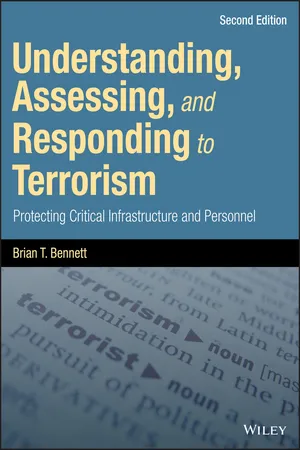
Understanding, Assessing, and Responding to Terrorism
Protecting Critical Infrastructure and Personnel
- English
- ePUB (mobile friendly)
- Available on iOS & Android
Understanding, Assessing, and Responding to Terrorism
Protecting Critical Infrastructure and Personnel
About this book
A comprehensive guide to understanding, assessing, and responding to terrorism in this modern age
This book provides readers with a thorough understanding of the types of attacks that may be perpetrated, and how to identify potential targets, conduct a meaningful vulnerability analysis, and apply protective measures to secure personnel and facilities. The new edition of Understanding, Assessing, and Responding to Terrorism updates existing material and includes several new topics that have emerged, including information on new international terrorist groups as well as a new chapter on Regulations and Standards.
A vulnerability analysis methodology, consisting of several steps—which include the techniques necessary to conduct a vulnerability analysis—is introduced and applied through several sample scenarios. By using easily customized templates for the screening process, valuation of a critical asset as a target, vulnerability analysis, security procedures, emergency response procedures, and training programs, the book offers a practical step-by-step process to help reduce risk. Each different type of terrorism is briefly discussed—however, the book focuses on those potential attacks that may involve weapons of mass destruction. There is a discussion of what physical and administrative enhancements can be implemented to improve a facility's ability to devalue, detect, deter, deny, delay, defend, respond, and recover to a real or threatened terrorist attack—whether it be at a facility, or in the community. Techniques on how personnel safety and security can be improved through the implementation of counter-terrorism programs are also outlined.
An overview of the major counter-terrorism regulations and standards are presented, along with the significant governmental efforts that have been implemented to help prevent terrorist attacks and foster preparedness at both private and public sector facilities and for personnel.
Understanding, Assessing, and Responding to Terrorism, Second Edition:
- Updates existing material, plus includes several new topics that have emerged including information on new international terrorist groups, new terrorist tactics, cyber terrorism, and Regulations and Standards
- Outlines techniques for improving facility and personnel safety and security through the implementation of counter-terrorism programs
- Unites the emergency response/public sector community with the private sector over infrastructure protection, thus allowing for easier communication between them
- Includes questions/exercises at the end of each chapter and a solutions manual to facilitate its use as a textbook
Understanding, Assessing, and Responding to Terrorism, Second Edition is a must-have reference for private and public sector risk managers, safety engineers, security professionals, facility managers, emergency responders, and others charged with protecting facilities and personnel from all types of hazards (accidental, intentional, and natural).
Frequently asked questions
- Essential is ideal for learners and professionals who enjoy exploring a wide range of subjects. Access the Essential Library with 800,000+ trusted titles and best-sellers across business, personal growth, and the humanities. Includes unlimited reading time and Standard Read Aloud voice.
- Complete: Perfect for advanced learners and researchers needing full, unrestricted access. Unlock 1.4M+ books across hundreds of subjects, including academic and specialized titles. The Complete Plan also includes advanced features like Premium Read Aloud and Research Assistant.
Please note we cannot support devices running on iOS 13 and Android 7 or earlier. Learn more about using the app.
Information
1
The Terrorist Threat
1.1 What Is Terrorism?
1.2 The History of Terrorism
Table of contents
- Cover
- Title Page
- Copyright
- Preface
- 1 The Terrorist Threat
- 2 Critical Infrastructure
- 3 Types of Terrorist Attacks
- 4 Weapons of Mass Destruction
- 5 The Terrorist's Preparation for an Attack
- 6 Risk and Threat Assessment
- 7 The Security Vulnerability Analysis
- 8 Principles of Protective Security
- 9 Effective Security Countermeasures
- 10 General Emergency Response Considerations
- 11 Emergency Response to a Weapon of Mass Destruction Attack
- 12 Homeland Security Laws, Regulations, and Standards
- Index
- EULA